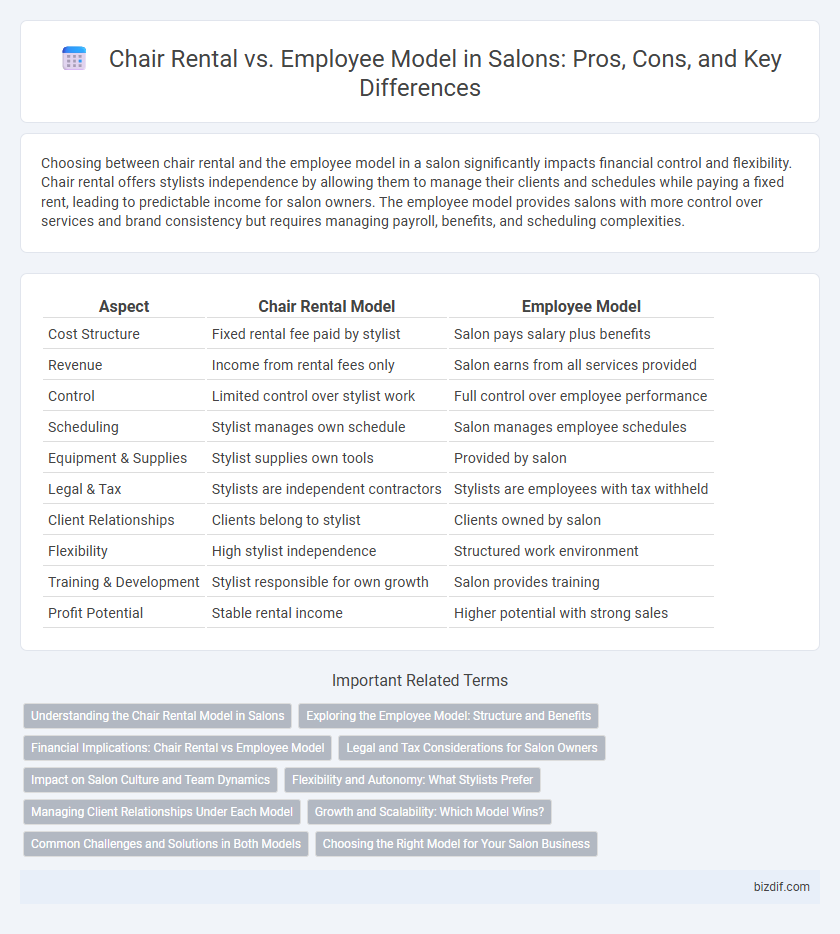Choosing between chair rental and the employee model in a salon significantly impacts financial control and flexibility. Chair rental offers stylists independence by allowing them to manage their clients and schedules while paying a fixed rent, leading to predictable income for salon owners. The employee model provides salons with more control over services and brand consistency but requires managing payroll, benefits, and scheduling complexities.
Table of Comparison
| Aspect | Chair Rental Model | Employee Model |
|---|---|---|
| Cost Structure | Fixed rental fee paid by stylist | Salon pays salary plus benefits |
| Revenue | Income from rental fees only | Salon earns from all services provided |
| Control | Limited control over stylist work | Full control over employee performance |
| Scheduling | Stylist manages own schedule | Salon manages employee schedules |
| Equipment & Supplies | Stylist supplies own tools | Provided by salon |
| Legal & Tax | Stylists are independent contractors | Stylists are employees with tax withheld |
| Client Relationships | Clients belong to stylist | Clients owned by salon |
| Flexibility | High stylist independence | Structured work environment |
| Training & Development | Stylist responsible for own growth | Salon provides training |
| Profit Potential | Stable rental income | Higher potential with strong sales |
Understanding the Chair Rental Model in Salons
The chair rental model in salons allows individual stylists to lease a chair or workspace within the salon, enabling them to operate as independent contractors who manage their own appointments, pricing, and client relationships. This model reduces the salon owner's overhead costs and administrative responsibilities while providing stylists with flexibility and entrepreneurial control. Chair rental is ideal for experienced professionals seeking autonomy and a personalized client experience without the constraints of employment.
Exploring the Employee Model: Structure and Benefits
The employee model in salons involves hiring stylists as staff members with a fixed salary or hourly wage, ensuring consistent team collaboration and quality control. This structure fosters a unified brand experience and allows salon owners to implement training programs and performance incentives effectively. Employee models often result in higher client retention rates and streamlined scheduling compared to chair rental setups.
Financial Implications: Chair Rental vs Employee Model
Choosing between chair rental and the employee model impacts salon finances significantly; chair rental provides steady, predictable income without payroll expenses, while employee models incur higher costs due to salaries, benefits, and tax obligations. Chair rental minimizes overhead and shifts business risks to the renter, but limits control over service quality and pricing. Employee models allow full managerial control and brand consistency, yet require greater financial investment and cash flow management.
Legal and Tax Considerations for Salon Owners
Salon owners must navigate distinct legal and tax implications when choosing between chair rental and employee models. The chair rental model classifies stylists as independent contractors, reducing payroll taxes but requiring strict contract compliance and liability clarity to avoid misclassification risks. Employing stylists mandates adherence to minimum wage laws, payroll taxes, workers' compensation, and employment benefits, necessitating comprehensive record-keeping and tax reporting.
Impact on Salon Culture and Team Dynamics
Chair rental fosters an independent atmosphere where stylists operate as entrepreneurs, potentially leading to less collaboration and cohesion within the salon team. The employee model promotes a unified culture with shared goals and consistent standards, enhancing teamwork and collective growth. Understanding these dynamics is crucial for salon owners aiming to balance individual creativity with a strong, supportive environment.
Flexibility and Autonomy: What Stylists Prefer
Stylists prefer chair rental models for the flexibility to set their own schedules and retain full control over their client base, enabling greater autonomy in their work. Unlike employee models, chair renters can manage pricing, services, and earnings without manager restrictions, fostering entrepreneurial growth. This autonomy attracts professionals who prioritize work-life balance and personalized business growth opportunities.
Managing Client Relationships Under Each Model
Chair rental empowers stylists to autonomously manage client relationships, fostering personalized service and direct customer loyalty. The employee model centralizes client management, allowing salons to maintain consistent customer experiences and streamline scheduling. Each system influences client retention strategies and appointment coordination, shaping overall business dynamics.
Growth and Scalability: Which Model Wins?
Chair rental offers rapid scalability by minimizing overhead costs and allowing salon owners to quickly increase the number of working stations without incurring employee-related liabilities. The employee model provides more control over service quality and brand consistency but requires significant investment in salaries, benefits, and training, which can slow growth. For salons prioritizing fast expansion, chair rental is often the winning model, while the employee structure suits those focused on building a cohesive team and long-term growth stability.
Common Challenges and Solutions in Both Models
Chair rental and employee models both face challenges such as managing scheduling conflicts, maintaining consistent service quality, and handling client retention effectively. Solutions include implementing robust booking systems, standardized training programs, and clear communication policies to ensure smooth operations and customer satisfaction. Efficient resource allocation and regular feedback loops help mitigate issues and optimize overall salon performance in either model.
Choosing the Right Model for Your Salon Business
Choosing the right model for your salon business depends on your financial goals and management style; chair rental offers independent stylists a fixed monthly fee and less employer responsibility, while the employee model provides greater control over staff and service quality. Chair rental can reduce overhead costs and administrative burdens, ideal for salons aiming to minimize risk, but it may limit revenue potential due to fixed rental income. The employee model requires investment in payroll and benefits, yet it enables consistent branding, customer experience, and higher profit margins through direct service sales.
Chair Rental vs Employee Model Infographic

 bizdif.com
bizdif.com